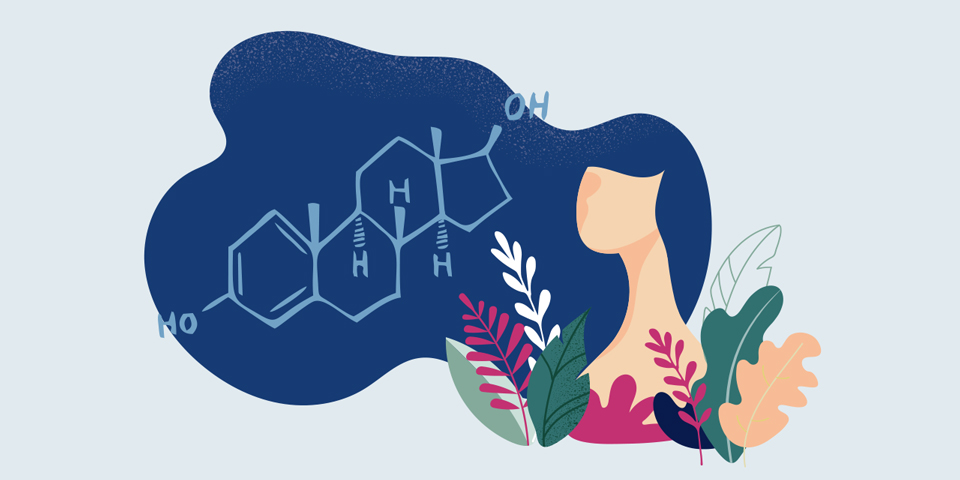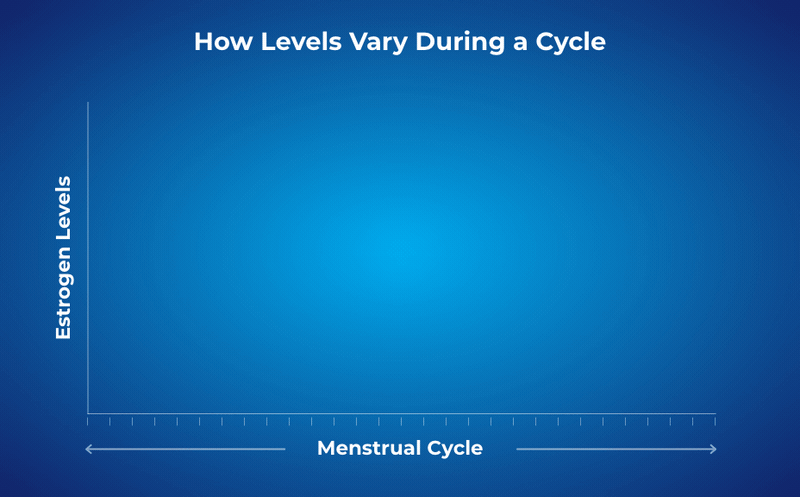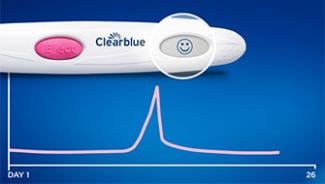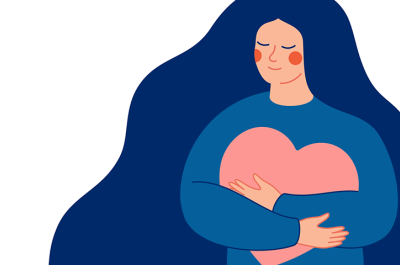What is estrogen? Understanding its roles and typical levels

Although estrogen is a powerhouse hormone that’s fairly well known, some of its attributes may surprise you. For example, did you know there are three main types of estrogen? Or that it’s normal for estrogen levels to fluctuate a lot? Here we take a closer look at what estrogen is and why it’s so essential.
What is estrogen?
Estrogen primarily affects sexual and reproductive development.1 It also can affect bone and heart health as well as muscles, breasts, skin, hair, mucous membranes, urinary tract and brain.1
Main types of estrogen
- Estrone (E1) is responsible for sexual development and function, and is the only form the body makes after menopause.2 However, it’s not as powerful as other types of estrogen pre-menopause.2 Estrone is often converted to estradiol.2
- Estradiol (E2) is a powerful form of estrogen that helps develop and maintain the reproductive system.3 It is the main form of estrogen the body makes during the reproductive years.3 Estradiol levels change throughout the menstrual cycle, resulting in the development and release of the egg and the thickening of the uterine lining.3
- Estriol (E3) helps the uterus grow, makes the body more sensitive to other pregnancy hormones and prepares the body for labor, delivery and breastfeeding.4 During pregnancy your baby makes a hormone that travels to your placenta, where it changes to estriol and then enters your bloodstream.4 Estriol levels continue to rise throughout pregnancy.4
During premenopause, estrogen is mainly produced by the ovaries and placenta, but small amounts are also made by fat tissue and the adrenal glands.3,5 While estrogen is a prominent and influential hormone in people assigned female at birth, the human endocrine system produces estrogen regardless of sex — though people assigned male at birth don’t typically produce as much.5
What does estrogen do?
Estrogen’s primary role is to encourage the reproductive system to develop, mature and function properly.5 During puberty, estrogen stimulates breast growth, pubic and underarm hair growth, and the start of menstrual cycles.3
Estrogen also helps regulate the menstrual cycle.6 Follicle-stimulating hormone signals the ovaries to stimulate the development of a follicle (egg) and causes estrogen levels to rise.6 After ovulation, the corpus luteum produces the hormone progesterone. Together, estrogen and progesterone stimulate the uterus and breasts to prepare for the possibility of fertilization.6 Estrogen, along with testosterone, also affects sexual desire, brain function, and bone, heart and skin health.3
How do estrogen levels change over time?
Estrogen levels rise and fall throughout each menstrual cycle, over the course of pregnancy and over the course of life. These levels can vary widely; for example, during the menstrual cycle of a premenopausal woman, the estradiol form of estrogen can range, on average, from 15 pg/mL to 350 pg/mL.7
Let’s take a closer look at how estrogen levels change during a typical menstrual cycle overall.
Estrogen levels during your menstrual cycle
On the first day of your period (the start of your menstrual cycle), your level of estrogen is at its lowest.6 Then, throughout the follicular phase, estrogen levels increase steadily.6 During ovulation, the level of estrogen in your body peaks, stimulating a luteinizing hormone (LH) surge.6 This is what causes a mature egg to be released from the ovary (aka, ovulation).
Ovulation tests can help you determine when this LH surge is taking place. During the luteal phase, if pregnancy occurs, estrogen levels remain high.6 If pregnancy doesn’t happen, estrogen levels begin to decrease.6 This drop in estrogen is why you may experience what some people refer to as a “menstrual migraine” right before your period is due.3

Estrogen levels during pregnancy
During pregnancy, the level of the estrogen hormone estriol starts to rise around week eight.4 Estriol continues to increase throughout pregnancy and is at its highest typically near the end of the pregnancy — about three weeks before the baby’s birth.4
Estrogen levels leading up to menopause
During perimenopause, estrogen levels start to decline.8 Your healthcare provider may ask that you have your estrogen levels tested if they suspect the levels are too low, as this may be a sign you’re approaching perimenopause.9 It’s important to know that test results can vary by health history, age, sex and the lab used.8
What can cause low estrogen levels?
A number of behaviors and biological conditions can result in lower estrogen levels, and remember: it’s common for levels to shift significantly over time. As we mentioned above, having consistently low estrogen could be a sign that you’re going through perimenopause or you’ve reached menopause.8
You could also have consistently low estrogen if you’ve had your ovaries removed or if you’ve gone through certain cancer treatments. Other documented causes of low estrogen can include:
- Genetic conditions
- Autoimmune diseases
- Conditions that affect your pituitary gland
- Primary ovarian insufficiency (POI, also known as premature menopause)
- Eating disorders
- Excessive exercise8
What are low estrogen symptoms?
Common signs of low estrogen can feel a lot like perimenopause and menopause symptoms, including periods that are less frequent or stop altogether.8 Delayed puberty, slowed bone growth and development, and mood swings can be symptoms of low levels of the estradiol type of estrogen.3 If you have any concerns about the symptoms of low estrogen, reach out to your doctor.
Can I increase low estrogen?
If you’re concerned about low estrogen levels, talk to your doctor. Your doctor is the best person to advise you on the cause as well as potential remedies based on your history and circumstances.
Depending on the cause of the low estrogen, your doctor may recommend certain diet and lifestyle changes, such as maintaining a healthy body weight, avoiding excessive exercise (but still exercising!), reducing stress and practicing good sleep habits to help increase estrogen.8 Your doctor may also consider hormone replacement therapy, which is more commonly used to treat the symptoms associated with menopause, but can involve estrogen therapy if you don’t have a uterus, or combined estrogen progesterone/progestin therapy if you do.10
Are there estrogen-rich foods? And could eating them increase estrogen levels?
Phytoestrogens, which are plant-based estrogens, can be found in foods such as legumes, seeds, berries and fruits, and supplements including black cohosh and red clover — but research on the efficacy of eating these foods to increase estrogen levels is mixed.10,11
What can cause high estrogen levels?
Estrogen dominance may be due to medication, or because your body isn’t producing enough progesterone, pushing estrogen production to go into overdrive.12 Estrogen dominance has been linked to irregular periods, PCOS, dense breast tissue, weight gain after menopause, endometriosis pain and some cancers.12 A blood test can help determine if you have elevated estrogen.12 Lifestyle and/or medication adjustments can help return estrogen levels to normal12, but talk to your doctor first as they can best advise you based on your history and circumstances.
Estrogen is a fascinating hormone that plays many important roles throughout life. If you have questions about estrogen and your health, reproductive or otherwise, talk to your healthcare provider. They can help you determine how this powerful hormone is affecting you and your health.
Related Articles
Sources :
- University of Rochester Medical Center. Low estrogen levels in menopause. Accessed January 16, 2023. https://www.urmc.rochester.edu/encyclopedia/content.aspx?ContentTypeID=85&ContentID=P00559
- Cleveland Clinic. Estrone. Last reviewed February 18, 2022. Accessed January 16, 2023. https://my.clevelandclinic.org/health/body/22398-estrone
- Endocrine Society. Reproductive hormones. Updated January 24, 2022. Accessed January 16, 2023. https://www.endocrine.org/patient-engagement/endocrine-library/hormones-and-endocrine-function/reproductive-hormones
- Cleveland Clinic. Estriol. Last reviewed February 18, 2022. Accessed January 16, 2023. https://my.clevelandclinic.org/health/articles/22399-estriol
- Britannica. Estrogen. Updated December 6, 2022. Accessed January 16, 2023. https://www.britannica.com/science/estrogen
- Merck Manual. Menstrual cycle. Updated September 2022. Accessed January 16, 2023. https://www.merckmanuals.com/home/women-s-health-issues/biology-of-the-female-reproductive-system/menstrual-cycle
- Mayo Clinic Laboratories. Estradiol, serum. Accessed February 2, 2023. https://www.mayocliniclabs.com/test-catalog/Overview/81816#Clinical-and-Interpretive
- Cleveland Clinic. Low estrogen. Last reviewed February 8, 2022. Accessed January 16, 2023. https://my.clevelandclinic.org/health/diseases/22354-low-estrogen
- University of Rochester Medical Center. Estradiol (blood). Accessed January 16, 2023.https://www.urmc.rochester.edu/encyclopedia/content.aspx?ContentTypeID=167&ContentID=estradiol
- The American College of Obstetricians and Gynecologists. The menopause years. Last reviewed November 2021. Accessed January 16, 2023 https://www.acog.org/womens-health/faqs/the-menopause-years
- Desmawati D, Sulastri D. Phytoestrogens and their health effect. Open Access Maced J Med Sci. 2019;7(3):495-499. doi: 10.3889/oamjms.2019.044. Published February 14, 2019. Accessed January 16, 2023. https://www.ncbi.nlm.nih.gov/pmc/articles/PMC6390141/
- Cleveland Clinic. High estrogen. Last reviewed February 9, 2022. Accessed January 16, 2023. https://my.clevelandclinic.org/health/diseases/22363-high-estrogen

How to identify your most fertile days
Knowing your most fertile days is key if you are trying for a baby. Discover the signs, symptoms and methods that can help you identify them.

Digital Ovulation Test: pinpoints your 2 most fertile days
In every cycle there are only a few days when a woman can conceive, so having sex on these days is very important if you are trying to get pregnant.




